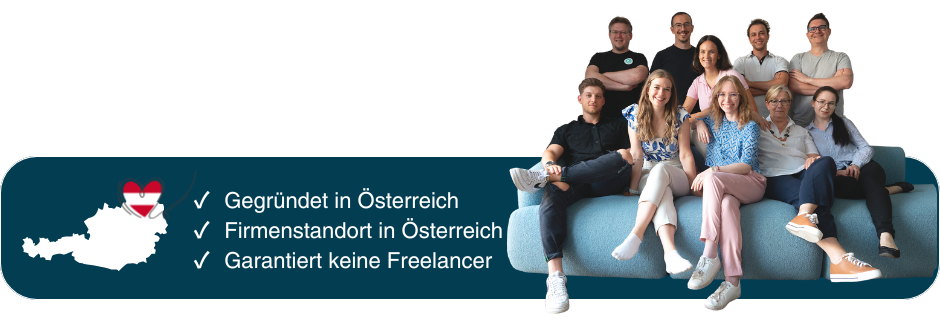The ultimate cheatsheet for a successful website
A successful website is at the heart of any online marketing strategy. Whether you're a small start-up or an established company, an attractive website is crucial to staying visible and competitive online. Because it can also convert users into customers. In this article, we'll tell you how to turn your website into a successful website.
Note: To get the most out of our blog post, it is helpful if you are already familiar with the following terms. If not, simply click on the relevant links to find out more in our glossary. We wish you much success and enjoyment with your training!
Successful website: This is what matters
Websites are a dime a dozen - and they all have very different purposes. But successful websites have a few key things in common:
- Clear goal
- Target group focus
- High security
- Attractive web design
- Fast loading time
- Search engine optimization (SEO)
- First-class content
- High user-friendliness
- Intuitive navigation
- Responsive design
10 tips for the success of your website
We will now take a closer look at the 10 points that make a successful website. In the best case scenario, your website will fulfill all the points to make your customers as happy as possible.
1. purpose of the website: Eyes on the target
A successful website does its job. That's why the question arises right at the beginning: What are the goals of the website?
The objectives of websites can be very different and vary greatly depending on the type of company, the industry and the specific needs of the target group. The most common goals include:
- Increase brand presence and awareness
- Gaining and retaining customers
- Information and education
- Sales and revenue growth
- Service and support for existing customers
- Interaction and commitment
It is essential to clearly and unambiguously define the goals of the website. This is the only way to measure and track success and carry out targeted optimizations.
Measuring the success of the website: The most important factors
Depending on your goals, you can now determine the factors by which the success of your website will be measured. Various analysis tools can provide you with information about the performance of your website.
The most important factors include:
- Traffic statistics (number of visitors, page views, new vs. returning visitors)
- Bounce rate
- Dwell time
- Conversion Rate
- User engagement (click rate, comments and feedback, social shares)
- ROI (return on investment)
2. define the target group: Focusing on the customer
Before you create a website, ask yourself the question: Who are you creating it for? As a company in particular, it is essential that you focus on your target group. Otherwise, your website runs the risk of being irrelevant.
When defining your target group, a number of different factors are important. You should consider demographic characteristics (age, gender, education, occupation, income) and psychographic characteristics (interests, lifestyle, values, behavior). This will help you get a clear picture of your target group and understand their needs, problems, motivations and preferences.
The main question you should ask yourself when creating your website: What problems does my target group have and how can my website help solve them? Your website should be specifically geared towards the needs of your target group (in terms of content and design).
Also important: In the course of time can your target group or their needs, problems and demands change. Use feedback, web analytics and market research to keep your website relevant to the current needs of your target audience.
3. safety: regular maintenance and optimization
Regular maintenance and optimization are essential in order to with websites to remain successful. This aspect is often underestimated, but it plays a crucial role in the security, performance and user experience of the website. What you should keep in mind:
- Security updates: Security gaps can that´s good Make your website vulnerable to hacker attacks. The content management system (CMS) and all plugins must always be up to date to avoid potential vulnerabilities.
- Content updates: Keep the content up-to-date and relevant. Regular updates and new content maintain both interest and ranking in search engine results.
- Links and interactive elements: Broken links or non-functioning interactive elements (e.g. forms) can lead to a poor user experience and affect the trust of the target group. Check all links and elements regularly and correct them if necessary.
4. optics: attractive web design
The same applies in the online world: first impressions are crucial. Visitors to your website form an opinion about your company within seconds. You can positively influence this opinion if the design of your website is professional, appealing and user-friendly.
This is what matters in design to:
- Clear and inviting layout
- Modern, clean design
- Easy to find and clear menu (navigation)
- Targeted structure of the content
- Easy to read font
- Harmonious color palette
- Sufficient white space (empty space) between the elements
- Eye-catching and clear call-to-action elements
- High-quality visual content (e.g. photos, videos)
- Consistency of the design
- branding
5. charging time: fast, inform, inform
An often overlooked factor in the website: The loading time. You probably know how annoying it is when you have to wait forever for the website and images to load completely or for the payment process to be completed. Nowadays, everything has to be fast.
Hence the basic rule: Ideally, the loading time of a website should be be very fast - and best of all less than one second. Both on the desktop as well as on mobile devices.
An often overlooked factor in the website: The loading time. You probably know how annoying it is when you have to wait forever for the website and images to load completely or for the payment process to be completed. Nowadays, everything has to be fast.
Hence the basic rule: Ideally, the loading time of a website should be be very fast - and best of all less than one second. Both on the desktop as well as on mobile devices.
The loading time affects many different factors on your website, including
- User experience (UX):
A fast website significantly improves the user experience. Studies show that a delay of just one second can drastically reduce visitor satisfaction. - Search engine ranking:
Google and other search engines consider loading speed as an important ranking factor. Nimble pages have a higher chance of appearing at the top of the search results. - Conversion rate:
A faster website often leads to higher conversion rates. Visitors are more likely to stay on the site, browse further and ultimately convert if the site is quickly loads.
You can measure the speed of your website with various tools, e.g. PageSpeed Insights from Google.
Is your website too slow? Here's what you can do to improve it:
- Optimize images:
Use compressed formats such as JPEG and WebP and reduce images to the required size. - Use browser caching:
Browser caching saves certain elements of the page locally on the user's device. This allows returning visitors to load the website more quickly. - Minimize HTTP requests:
Combine files (images, scripts, CSS files) to reduce the number of HTTP requests. - Content Delivery Network (CDN):
A CDN distributes website content across several servers worldwide so that the data is loaded from a server that is geographically closer to the user.
And if that all sounds too complicated for you... Then simply have your website created by our agency! We will be happy to discuss your wishes and requirements in a non-binding and free initial consultation.
6 SEO: Being found on the Internet
SEO, or Search Engine Optimization, is crucial to ensure that the website is found. SEO aims to optimize a website for a specific search query so that Google considers it relevant and therefore displays it at the top of the search results. This is what matters:
- Keyword strategy (research and definition of search terms used by the target group)
- High-quality content (added value for the target group)
- Technical optimization (loading time, optimization for mobile devices, user-friendly navigation, search engine-friendly code, etc.)
- Backlink building (links from other websites that lead to your website)
- Local SEO (optimization of Google My Business, relevance for local search queries)
Search engine optimization can be complex and time-consuming, especially for companies that want to focus on their core business. As an experienced SEO agency, we help you to achieve the best results and ensure that your website is visible in search results.
SEO is not a sprint, but a marathon. It requires continuous monitoring and adaptation. Google is constantly updating its algorithm and the competition is also changing. That's why you always have to stay on the ball to ensure that your website achieves a good ranking - and maintains it.
Search engine optimization can be complex and time-consuming, especially for companies that want to focus on their core business. As an experienced SEO agency, we help you to achieve the best results and ensure that your website is visible in search results.
7. content: Content is King/Queen
The maxim "content is king (or queen)" still applies in the world of online marketing. But why is good content so important?
- Search engine optimization (SEO) - Search engines such as Google prefer websites with high-quality and relevant content - partly because users should always receive the best results.
- Customer loyalty - High-quality content helps to arouse the interest of visitors, keep them on the website and gain the trust of the target group.
- Branding - The content reflects your brand - your website is your business card on the Internet.
How do you create great content?
- Everything for your target group:
Create content that offers your visitors and customers real added value. - Originality:
Offer unique content. Don't just copy content from other websites. - Actuality:
Renew content regularly to keep your website up-to-date and relevant. - Multimedia content:
Don't just use text, but also images, videos, infographics and interactive elements to make your website attractive and get your message across effectively.
Our conclusion: Not only the design, but also the content of your site is important for a good (first) impression.
8. user-friendliness: user experience and usability
A positive user experience (UX) and high usability can make the difference between a successful website and one that frustrates and drives visitors away.
User Experience (UX) encompasses all aspects of a user's interaction with a website or application. A positive UX aims to provide visitors with a seamless, pleasant and efficient experience on a website. This includes the design of the user interface, the comprehensibility of the content and the speed of the page.
Usability on the other hand, refers to the user-friendliness of a website. A user-friendly website is intuitive and easy to use - even for people without technical expertise. This means that the following things are important:
- Clear navigation
- Easy to read texts
- Attractive pictures
- Sophisticated page structure
- Accessibility
A website with a first-class user experience and high usability can not only increase visitor satisfaction, but also increase the time they spend on the site, improve conversion rates and ultimately lead to more sales. Investing in UX and usability optimization is therefore essential for any online marketing agency to help their clients build a successful website.
9. structure & navigation: following the customer journey
A successful website is characterized by user-friendly navigation so that users can find what they are looking for quickly and easily. Ideally, the structure and navigation should correspond to the customer journey.
But what does that mean in concrete terms?
In the marketing world, the customer journey describes the process that a customer goes through before making a purchase decision. It begins with the first contact with the company and ideally ends with a satisfied and returning customer.
The most important phases are
- Awareness: The customer has a problem or need and starts looking for a solution.
- Consideration: The customer compares different companies and providers.
- Decision: The customer buys a product or service.
- After the purchase: The experience is evaluated and the customer ideally becomes a returning customer and recommends the company to others.
To optimally adapt the website navigation to the customer journey, you should consider the following aspects:
- Clear and intuitive structure:
The website must be easy to understand for first-time visitors. Clear categories and meaningful menu items help to pick up visitors at the various stages of the customer journey. - Provide relevant content:
Visitors must be able to find relevant content easily at every stage of the customer journey. - Call-to-actions:
Targeted calls to action (contact forms, links to the store, product presentations, newsletter registrations, etc.) should be placed in such a way that they lead the user to the next step in the customer journey. - Search function and filter:
A well-functioning search function and useful filter options enable users to find the information they need immediately. - Responsive design:
The website must be consistent and user-friendly to navigate on both desktop and mobile devices. Therefore, always rely on responsive design!
10. responsive website: Don't forget mobile devices
Are you reading this text on your desktop, cell phone or tablet? Statistically, it is most likely that you are holding a cell phone or tablet in your hand. But regardless of this, we have made sure that our website is displayed correctly on all devices and in all common browsers. This is called responsive web design. And you should do it too. A responsive website is not just a "nice-to-have", but a must for any successful online presence.
The advantages of a responsive website:
- Increased range and accessibility:
If the website is not optimized for mobile devices, you are missing out on potential customers who may quickly leave your website because it is difficult to navigate. - Improved user experience:
A responsive website ensures that the content is easy to read and navigation is intuitive - regardless of the device. - SEO benefits:
Search engines like Google prefer responsive websites. A mobile-friendly site can improve search engine rankings.
Among other things, this is what a responsive website is all about:
- Flexible layout:
Use a flowing grid layout that adapts to different screen formats. No container should go "over the edge" or be cut off unfavorably. - Touch-friendly navigation:
Menus and buttons should be large enough to be easily operated with a finger. Avoid small, closely spaced links. - Tests on different devices and screen sizes:
Tools such as BrowserStack or Google Mobile-Friendly Test can be very helpful here.
Does that sound too complicated for you? Contact us without obligation and we will create your page for you!
Extra tip: Simply have your successful website created by professionals
Is the whole thing too complicated or time-consuming for you? It's true, creating a website takes a lot of time and effort - especially if you have no experience with CMS, web design, search engine optimization, domain, hosting and all the other technical stuff.
But there is good news: As a professional online marketing agency, we can do all the work for you and get your website online within a few weeks. On request, we can provide you with an SEO-optimized website including content, mobile optimization, web design, maintenance and more.
Sounds exciting? Then get in touch with us right away to discuss your ideas, options and further details. The initial consultation with us is free and non-binding!






